Basil Pesto Pasta
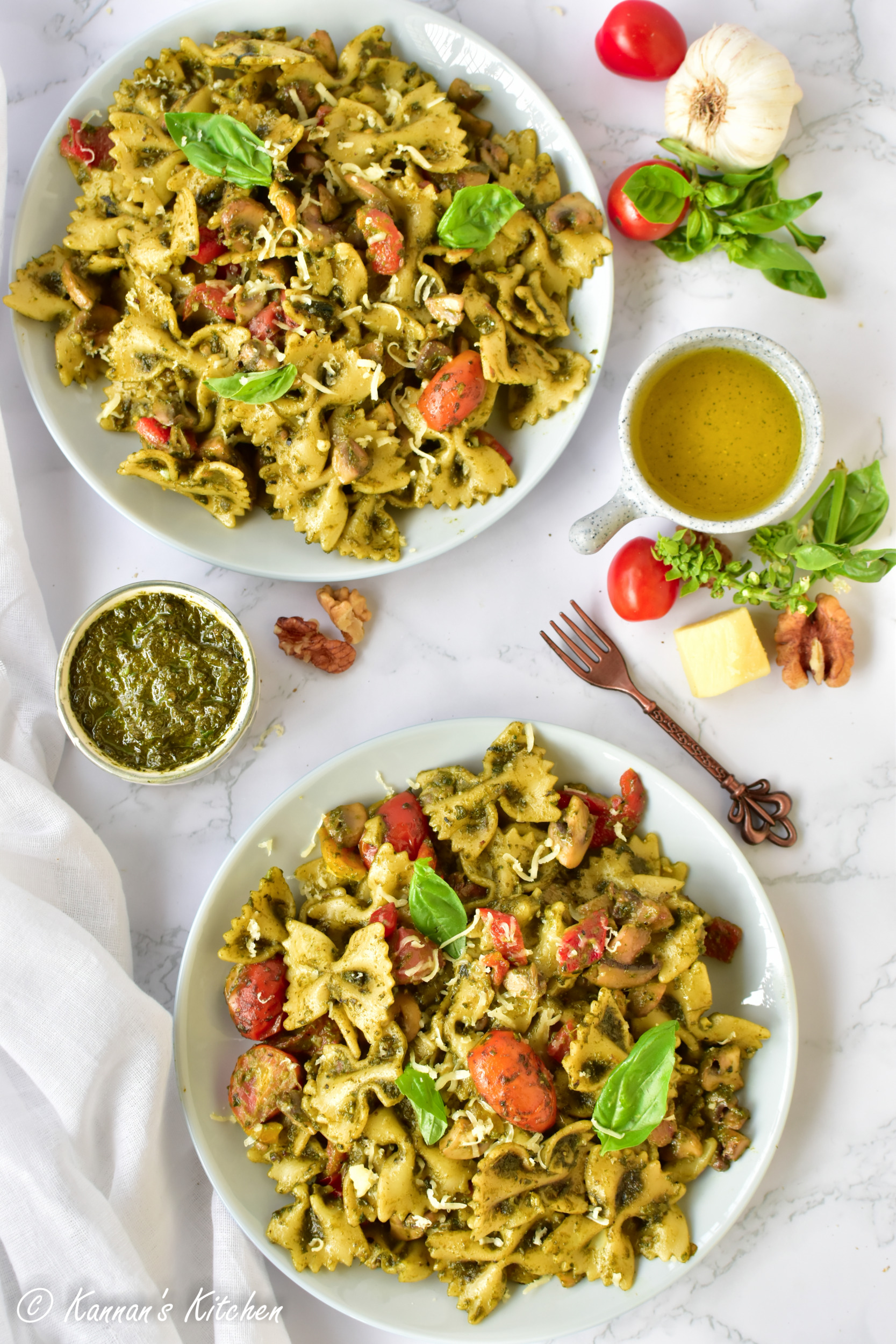
When we talk about Italian food, the two most popular dishes that comes to everyone’s mind are Pizza and Pasta. Further, when we talk about Pasta, we would generally think of the Tomato based Arrabbiata sauce and Béchamel or White Sauce based pasta. But there is a lot more to Pasta and one such classic variation that we are going to discuss in this post is Basil Pesto based Pasta.
What is Pesto?
‘Pesto’ in Italian literally translates to ‘to pound or crush’. It is a condiment that is made with a variety of fresh ingredients like basil, cheese and olive oil by pounding them in a traditional pestle and mortar. In simple Indian terms, Pesto can be thought as the Italian version of a chutney. Basil Pesto is one of the most popular Pesto which is made with fresh Italian basil, garlic, pine nuts, parmesan cheese, extra virgin olive oil, crushed salt and pepper.
Basil Pesto is such a popular version of Pesto that many refer to it as just ‘Pesto’. It might not be incorrect in saying that for many, this is the only Pesto that they might know. However contrary to this belief, there are numerous other variations of Pesto and to name a few – sun-dried tomatoes pesto, cherry tomato & basil pesto, citrus fruits based pesto etc. In this post, we are however going to be discussing only about the Basil Pesto.
What is Pesto used for?
Pesto is a versatile condiment which is used in various Italian dishes ranging from Pasta, Pizza, as a spread for various breads and toasts and also in salads.
When we talk about the use in Pasta, this Pesto can act as the base sauce and is more than enough to pack flavours and taste. Italian food is simple and minimal when it comes to ingredients, however it bursts with flavours and this is what makes Italian cuisine so unique.
Basil Pesto is also used as an additional topping for pizza and pairs beautifully with the base Napoletana sauce.
When it comes to breads, this Pesto can be used as a spread which tastes simply amazing. All you need is a rustic bread like a sour-dough bread toasted slightly in olive oil and apply a generous amount of pesto and that’s it! It tastes divine. You can also use this as a base spread when making Bruschetta.
Pesto can also be used for salad dressing and Basil pesto especially pairs very well with any salad containing fresh tomatoes and feta cheese.
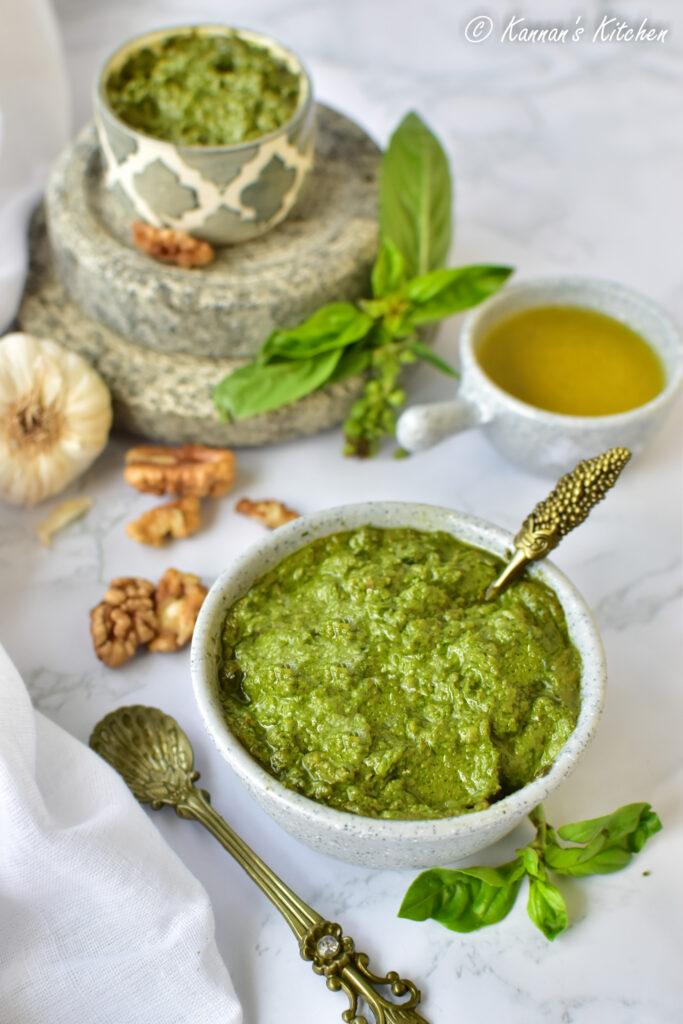
How to prepare Basil Pesto?
Basil Pesto is really a simple recipe containing only very few ingredients:
Italian Basil -This obviously is the most important ingredient for this pesto. Look for Italian basil with small and bright green leaves for making this pesto. Discard any of the leaves which are black in colour.
Garlic – Typically few raw garlic cloves are used in this recipe and trust me you do not get that raw smell when you have this pesto! However if you are particular about the smell, you could slightly roast the garlic and then use for making pesto.
Pine nuts – Usually pine nuts are used in this recipe and tastes great. However it is not commonly available in India, so you could use walnuts as an alternative. In addition to this I use a small amount of roasted and peeled peanuts when not using pine nuts, it tastes equally great.
Cheese – Normally a hard cheese like Parmesan cheese is used in this recipe. If you are unable to source this in your region, you could also use a mature Cheddar cheese and tastes equally good.
Extra Virgin Olive Oil – Italian cooking is incomplete without olive oil and this recipe demands a good quality extra virgin olive oil. A fairly good amount of oil is used in this recipe to emulsify with the other ingredients, as it is to be noted that no water is added while grinding the pesto.
All the above ingredients (except cheese and olive oil) are traditionally pound in a large pestle and mortar till it forms a homogeneous paste. Cheese and olive oil are added only once the nuts, garlic and basil are pound well.
It is to be noted that this pesto tends to oxidize and turn slightly black when the top layer is exposed to air. To avoid this, apply a layer of olive oil on top and cover with a clingfilm such that there is no gap or air between the clingfilm and pesto. This pesto tastes best when served fresh however you could refrigerate it up to 2 days and consume as required.
Basil Pesto Pasta
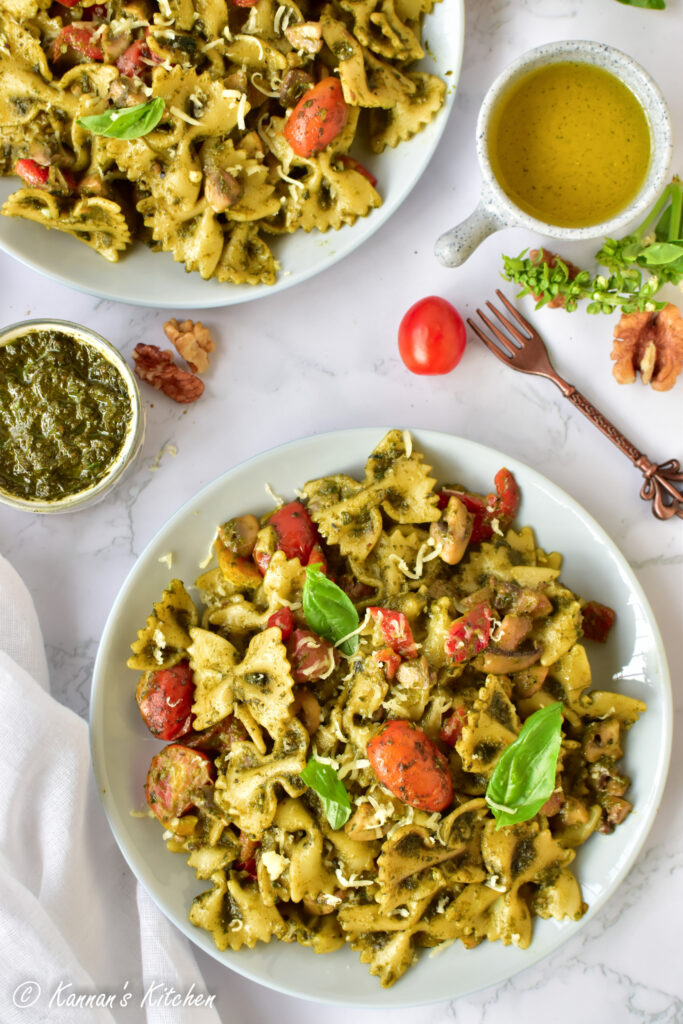
Now that we have discussed the Basil Pesto, let us discuss how to make a delicious pasta using this pesto. Basil pesto can be used in entirety as a main sauce for making a pasta and it tastes fabulous. The uniqueness of this pasta is its simplicity and not overpowering with other additional ingredients and let the pesto hero the flavours.
When it comes to pasta type, there are numerous shapes that are available in the market. But it is important to note that certain pasta shapes pair well with certain sauce types. This is for a simple reason that how well the sauce can coat the pasta and stick to it. When we talk about Basil Pesto pasta, though you could use any pasta shape of your choice, but I recommend using Farfalle pasta (in butterfly shape as shown in above picture), Penne pasta or Spaghetti. Use a good quality durum wheat Italian pasta for the best results.
Talking about the veggies that you could use in this pasta, here are some classic suggestions. The most important one being Cherry or Baby plump tomatoes. Tomatoes and basil are match made in heaven, so how could we separate them in this recipe! Roasting the cherry tomatoes enhances the flavour. In addition to this I like using roasted red and yellow bell peppers which also become wonderfully sweet after charring them over flame directly. Lastly, mushrooms sautéed in butter also make a great addition to this recipe. You could also use broccoli if you don’t like mushrooms.
It is to be noted that this pasta is light as compared to other pasta varieties as it is not loaded with heavy sauce. It also makes this dish great from a calorie point of view as it is not loaded with cheese or butter.
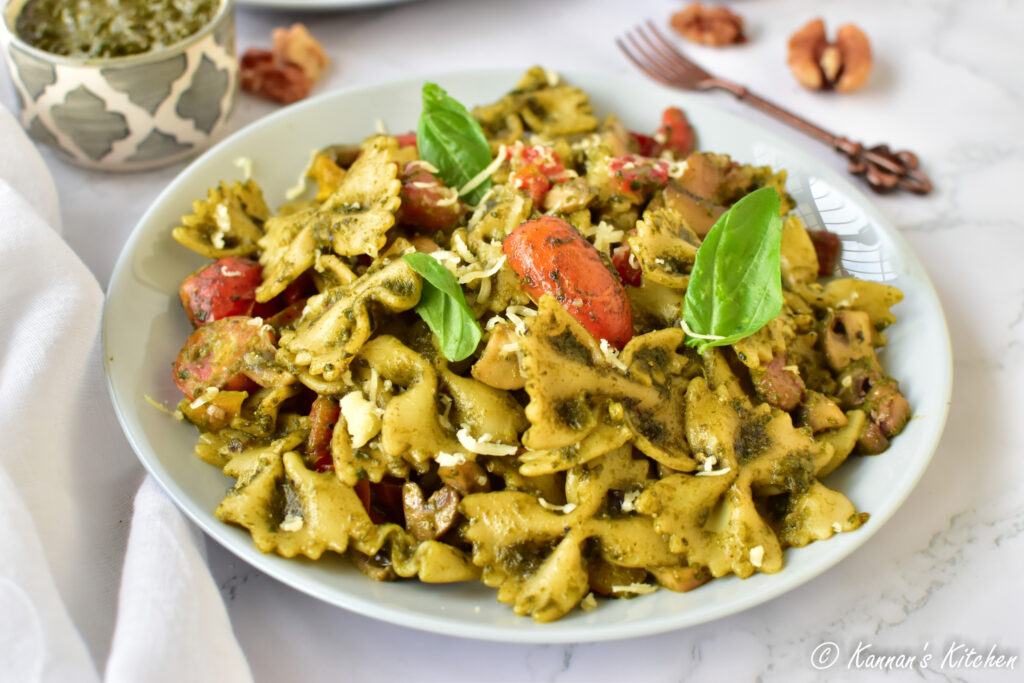
Serving Suggestion
Basil Pesto can be used in various forms along with Pasta, Pizza, toasts and salads as called out in the above section. It can be used as a condiment for other Italian based starters.
Basil Pesto pasta is a complete meal in itself as it is loaded with veggies. Grate a small amount of parmesan or cheddar cheese on top of hot pasta while serving.
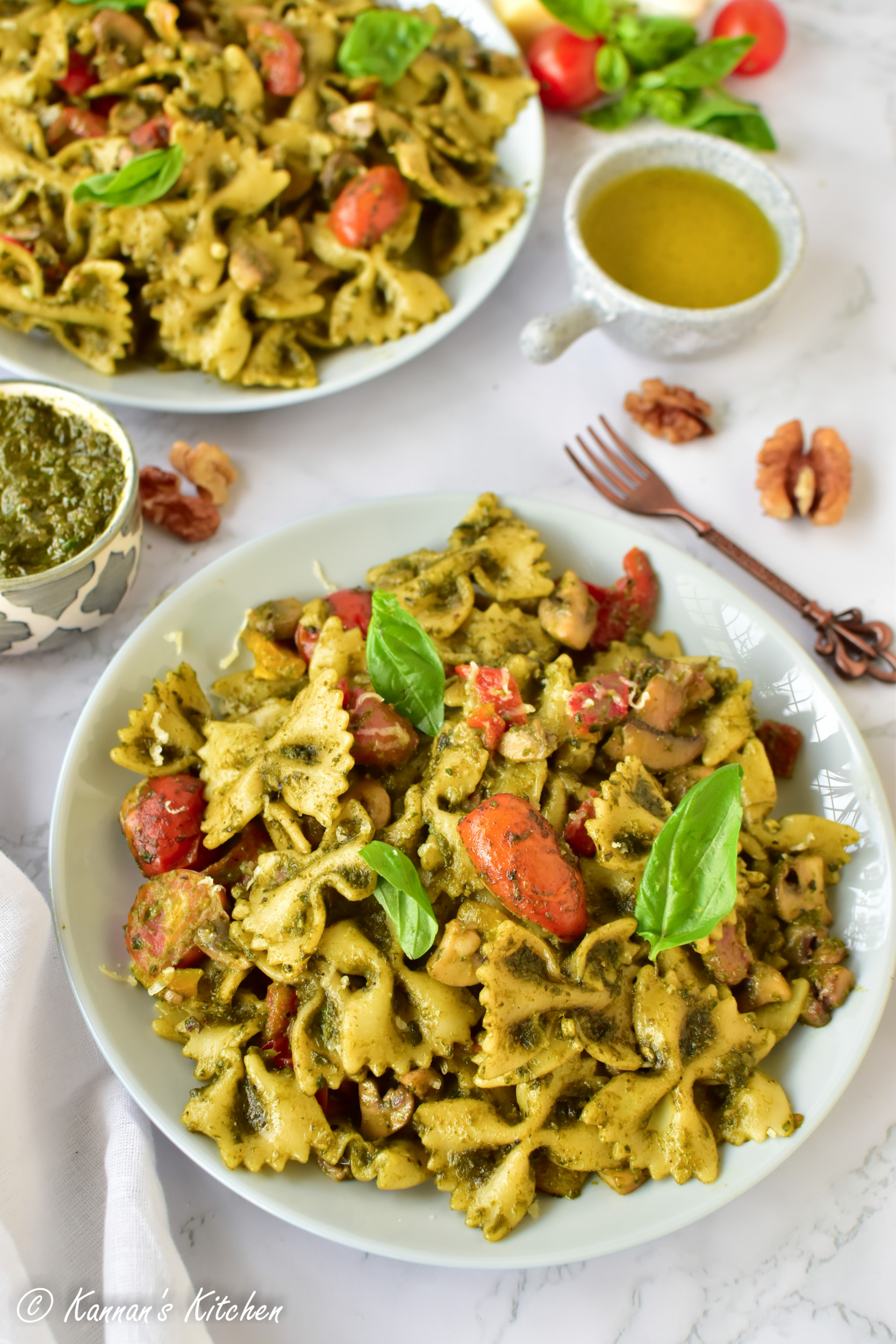
Basil Pesto Pasta
Ingredients
Basil Pesto
- 2 Packed Cups Italian Basil Leaves approx 120 grams
- ¼ Cup Walnuts
- 2 tbsp Roasted and Peeled Peanuts
- 4 cloves Garlic
- ½ Cup Grated Parmesan or Mature Cheddar Cheese
- ⅓ Cup Extra Virgin Olive Oil
- Sea Salt to taste
- ¼ tsp Ground Pepper
- *Note – If you are using Pine Nuts, replace the walnuts and peanuts with ⅓ Cup Pine nuts
Basil Pesto Pasta
- 300 grams Farfalle Pasta or Pasta of your choice
- 1 Red Capsicum
- 1 Yellow Capsicum
- 12-15 Cherry Tomatoes
- 200 grams Mushroom
- 4 cloves Garlic
- 1 tbsp Butter
- 1 tbsp Olive Oil
- Grated Parmesan or Cheddar Cheese for garnishing
- Salt & Pepper to taste
Instructions
- Wash the basil and pat dry. Chop the basil leaves without bruising them.
- In a pestle & mortar or a food processer, add the walnuts and peanuts (or pine nuts) and garlic and pound them till they are coarsely ground.
- Once the nuts are pound, add the chopped basil leaves and pound or pulse grind them.
- Once the basil leaves are ground, add the grated cheese. Pulse grind couple of times.
- Now add extra virgin olive oil, salt and pepper and blitz on low speed till the oil is incorporated well. Do not add water while making pesto.
- Basil Pesto is ready. Add 1 tablespoon of olive oil on top after transferring to bowl to avoid oxidizing of the basil.
- Bring water to a roaring boil and add plenty of salt to water and add the pasta.
- When the pasta is cooked to al dente (with still a bite to it), drain the pasta and rinse once in cold water. Add some olive oil on top and mix well to avoid sticking.
- Apply a small amount of oil on the red and yellow capsicum and grill them on flame directly till it is completely charred.
- The capsicum or bell peppers must look like this after roasting.
- Peel the skin of the bell peppers and remove the seeds from inside and chop them fine.
- In a pan, add some olive oil and chopped garlic and then add the cherry tomatoes (halved) and sprinkle some salt and roast till the skin starts shrinking.
- Once the tomatoes have roasted, add the chopped roasted capsicum and mix well.
- In a separate pan, heat butter and cook the chopped mushrooms on high flame. Once cooked and brown in colour, add salt and pepper to taste.
- Now add the cooked pasta and give it a toss. Add the cooked mushrooms and required amount of basil pesto.
- Mix well and cook for just a minute.
- Add grated parmesan or cheddar cheese on top while serving.
Notes
- Pesto tastes best when made in pestle and mortar, however bit time consuming to pound it fine.
- If you are vegetarian, be cautious while using parmesan cheese as the conventional parmesan cheese contains animal rennet, so look for the parmesan cheese with vegetable rennet.
- Do not add water while grinding the pesto. If you feel that the pesto is dry, add more olive oil.
- In this recipe, I have used a combination of 1/4th cup Walnuts and 2 tablespoons roasted and peeled peanuts, however if you have pine nuts you could replace both these ingredients with 1/3rd cup pine nuts.
- Try using a hard cheese like parmesan or mature cheddar cheese for the pesto. Processed cheese might not work good for this recipe.
- Basil pesto tends to turn slightly blackish green on top due to oxidizing of the basil. If you just mix it again, the colour is restored. Alternatively, you could add few drops of lime juice to prevent this.
- While storing the pesto, wrap it in a clingfilm with the clingfilm touching the top layer of the pesto and ensuring that there is no air in between. This way the pesto stays fresh for longer.
- Cherry tomatoes work great for this pasta, however if you do not have cherry tomatoes, you can use the regular ones too.
- Roasting the bell peppers make them incredibly sweet and tasty.
- If you prefer a milder flavour of pesto in the pasta, do not add the entire pesto at once and add as required.
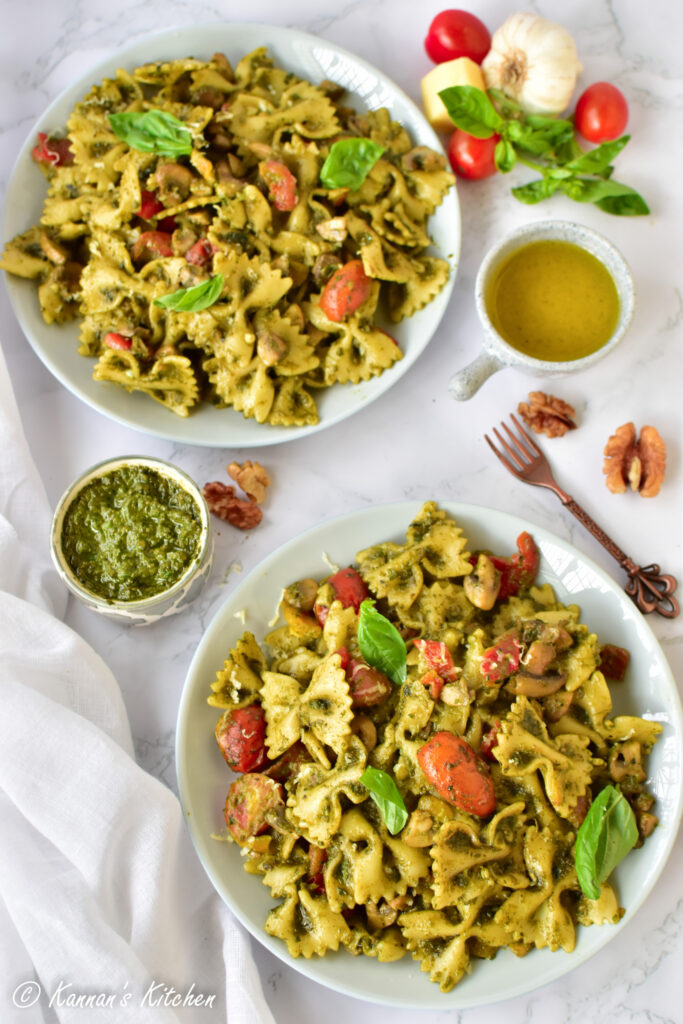



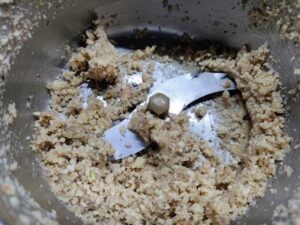
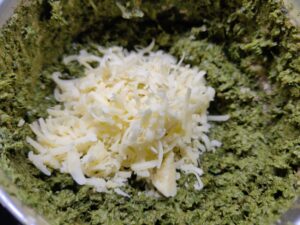
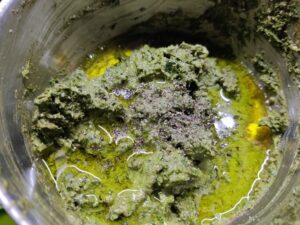
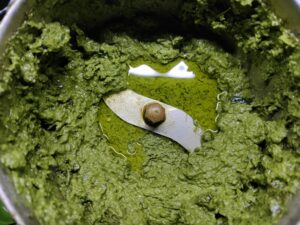
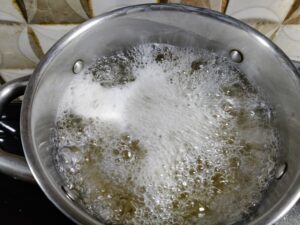
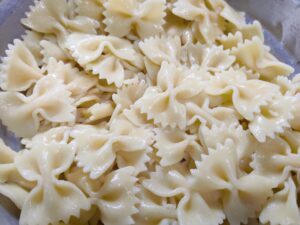

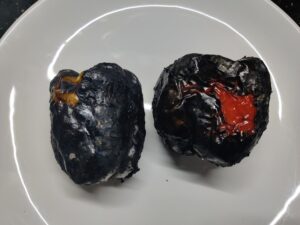
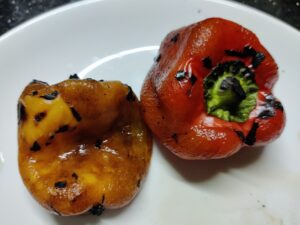
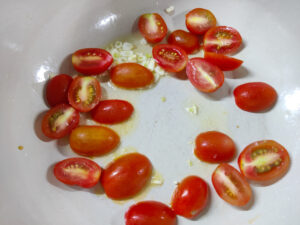
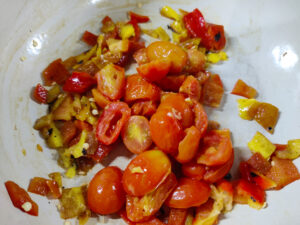
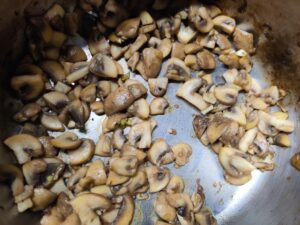


I was pretty pleased to discover this great site. I need to to thank you for your time for this particularly fantastic read!! I definitely appreciated every part of it and I have you book marked to see new stuff on your blog.
Thank you 🙂